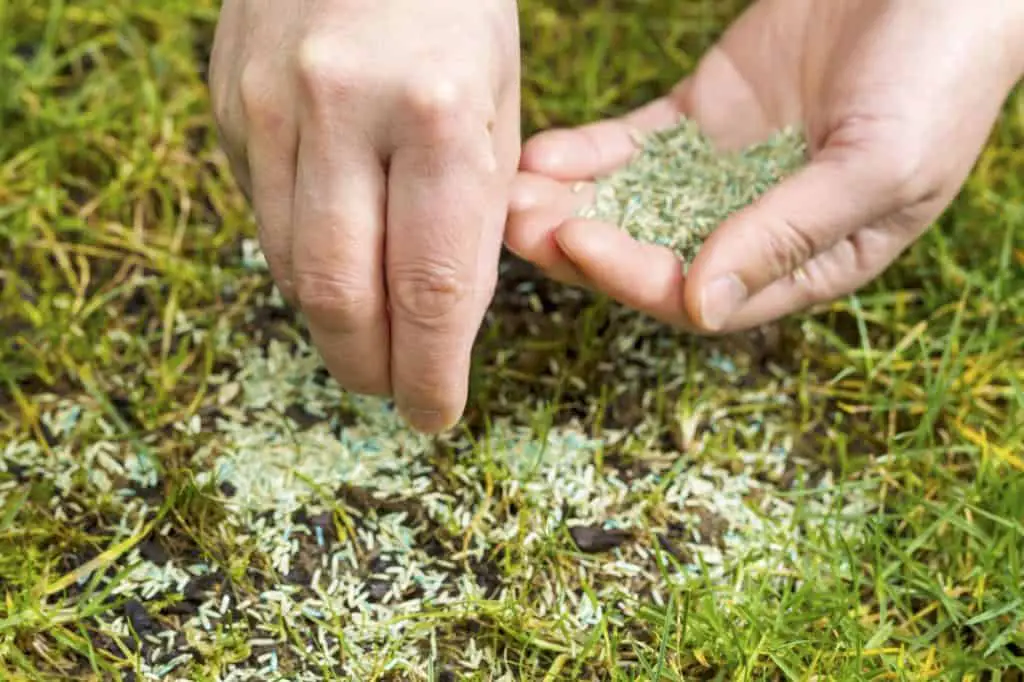There’s nothing quite like the smell of grass in the springtime. Having real grass in your backyard or front yard can really make the area feel more homely, and give you a bit of nature that you can access any time you like.
But the tricky thing is, as with any other plant you want to look after and nurture, there can be several ways that things can go wrong. So, it pays to read articles like this one, and to know what you’re doing before you start.

In this article, we’re going to look at whether you can put grass seed on top of grass, and we’re also going to answer several of your most frequently asked questions on the subject.
Table of Contents
Can I Put Grass Seed On Top Of Grass?
We’re very pleased to start this article off with some good news…
There is a name for spreading grass seed over an existing lawn, and it’s overseeding. Now, I know that at first that sounds like a bad thing, however I can assure you that it’s not.
Overseeding is a widely used method of keeping grassy areas competitive, allowing grass to thrive in areas where the grass has started to thin, and can help to keep your lawn lush and green.
It’s a great, convenient way of getting your lawn looking smart and very green once again, without having to start again from scratch.
But, and it’s a big but, you have to get it done right. It’s not as simple as sprinkling some extra grass seed over your lawn. Which leads us nicely on to our first FAQ.
Can You Just Sprinkle Grass Seed On A Lawn?
The short answer to this question is No.
Here is our quick guide on how best to sprinkle grass seed on an existing lawn for best results:
How Best To Overseed Your Existing Lawn
Testing The Soil
The first step in overseeding your existing lawn is to ascertain what has been going wrong so far. It may be that the grass speed was not spread sufficiently evenly initially, or perhaps a pet has dug up some seeds in certain patches.
Or it could be that there’s an issue with the soil. It could be the wrong type of soil, or it could be lacking in some of the important nutrients required to grow grass. This is why one of the first steps you should take in overseeding your lawn is to test the soil.
To test the soil all you have to do is buy a soil test kit (you can get these readily online from retailers such as Amazon) and carry out the soil test as per the kit’s instructions.
Get the Timing Right
When you are satisfied that the lawn’s soil is suitable for growing more grass, then the next step is to ascertain the best timing for the overseeding.
In the Northern regions the best time to overseed your lawn is in late summer to early fall. In Southern regions on the other hand, overseeding should be carried out in the late spring.
However, this is not the only criteria to go buy. The best time for overseeding your lawn is also determined by the type of grass seed being used. For most species, spring is the best time to overseed the lawn.
If you are overseeding purely to get more winter coverage, you could get away with overseeding in early fall, but in most cases spring would be best.
Remove Any Dead Grass
This is a necessary step, more on that very shortly.
Sowing the Seed
Select a good grass seed and sow the seeds according to label-recommended overseeding rates. It is ok to concentrate on the barest patches, so long as you’re careful not to put too much in one big clump.
Rake the Lawn
This is a necessary step, more on that very shortly.
Fertilize the Overseeded Areas
Use an appropriate fertilizer to fertilize the ground where you have been overseeding. Use according to the labeled instructions.
Water Your Overseeded Lawn
This is also a very important step. Newly overseeded lawns need a lot of moisture. Do light waterings twice a day for the first four days, followed by watering more heavily every other day for the next five days.
Return To Regular Maintenance
This is also a very important step. It is important to keep looking after your lawn after you have overseeded it, or you could risk the grass dying off.
Can You Put Down Too Much Grass Seed?
As much as we like to encourage overseeding for greener lawns, there is unfortunately such a thing as putting down too much grass seed. Too much grass seed causes undue competition for resources between the grasses. They will be fighting for light, water and nutrients.
It’s pretty hard to judge exactly how much grass seed is too much. The trick here really is to distribute the grass seed as evenly as possible.
The more evenly the grass is distributed across a lawn, the better access it has to light, water and nutrients, and the less the grass seeds will have to compete with each other for these precious resources.
Can You Seed Over Existing Grass?
As we have already discussed, you can seed over existing grass with much success. This is known as overseeding.
Overseeding can be a great way to improve the appearance of your lawn without having to start all over again from scratch, cutting out quite a lot of unnecessary work.
But as we have already mentioned there are several ways that this overseeding can go wrong, which is why we put together a short guide on How Best To Overseed Your Existing Lawn. Please scroll back up for further information and details.
Do I Need To Rake In Grass Seed?
The shorter answer to this question, is Yes, you do.
The grass seed will need to come into contact with soil in order for it to germinate and grow.
Failing to rake the area once the seed has been sprinkled over means that the grass seeds too will fail to grow.
Do I Need To Remove Dead Grass Before Seeding?
The shorter answer to this question, is Yes, you do.
Sure, removing the dead grass means more work than simply sprinkling more grass seed over the top, but to be frank, it’s a necessity. Here’s why…
If dead grass has been allowed to build up on your lawn, it weakens the surrounding grass around it, causing even more of it to die off. So to plant even more grass seed in these conditions would be utterly futile.
If you have more than a half inch of dead grass anywhere in your lawn it needs to be completely removed before any new seed is planted.
An easy way to remove dead grass is by using a spring-tine rake with a strong upward pull.
Should I Put Topsoil Over Grass Seed?
The shorter answer to this question, is No…
Not only do you not need to turn your topsoil over, but placing topsoil over your grass seeds is actually very bad for the grass.
Placing topsoil over newly planted seed can actually suffocate the grass seedlings and they will never even have the chance to get started.
